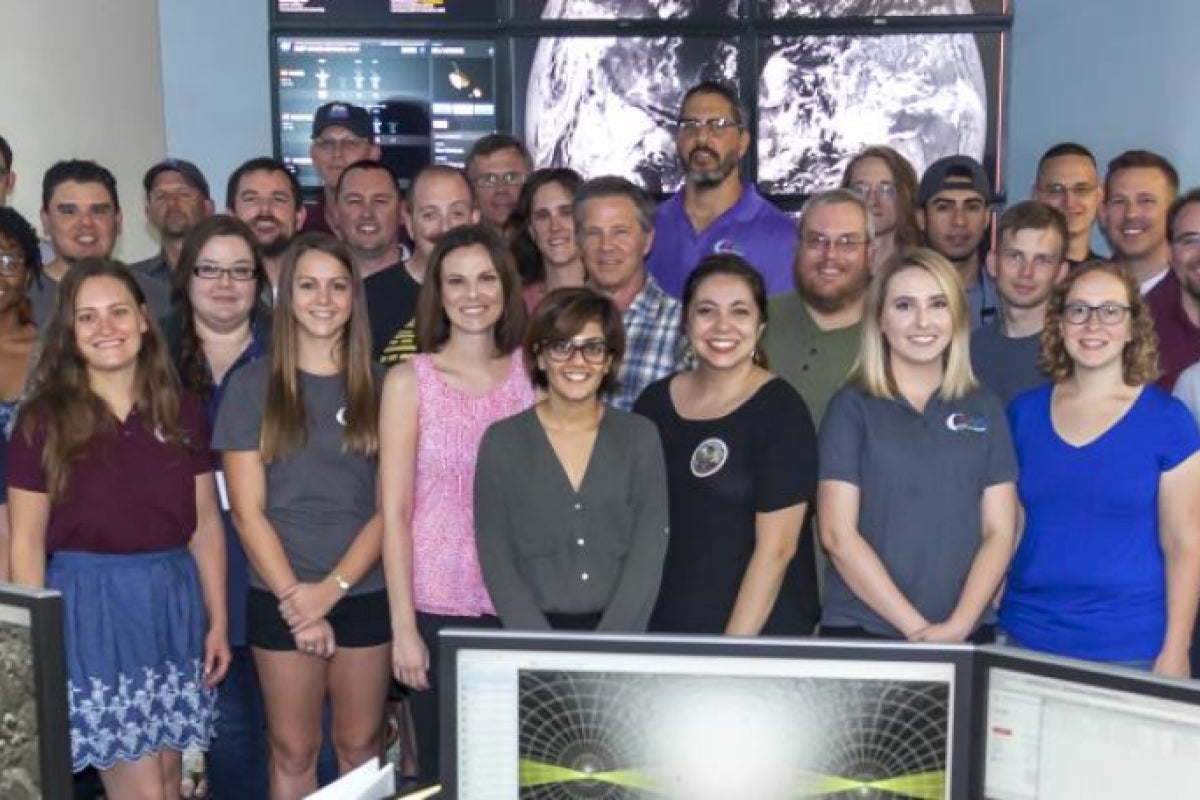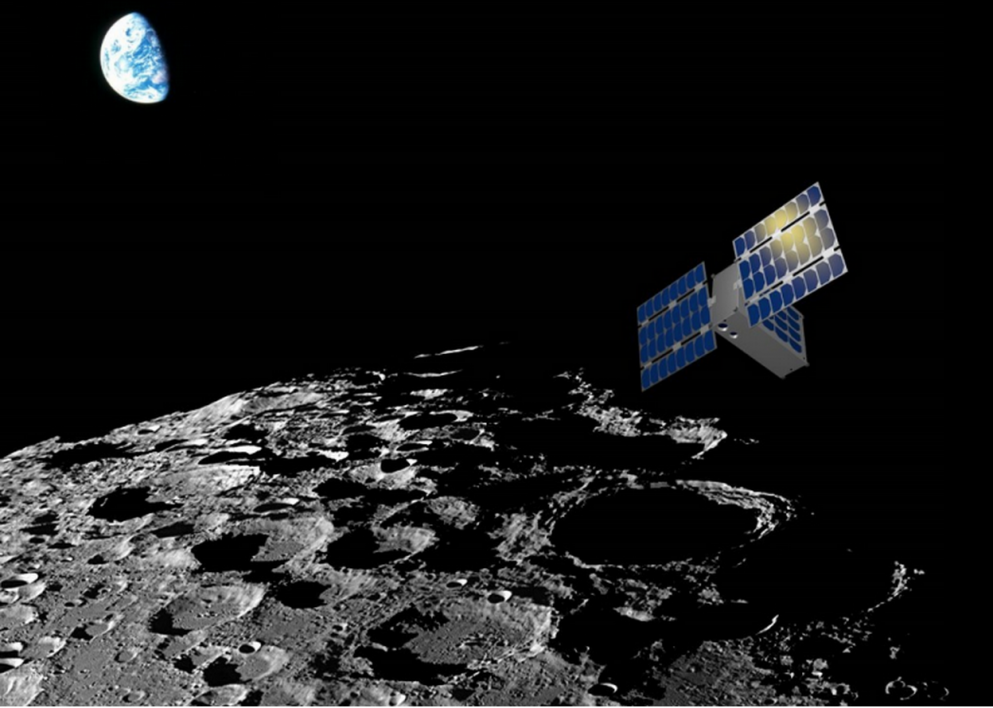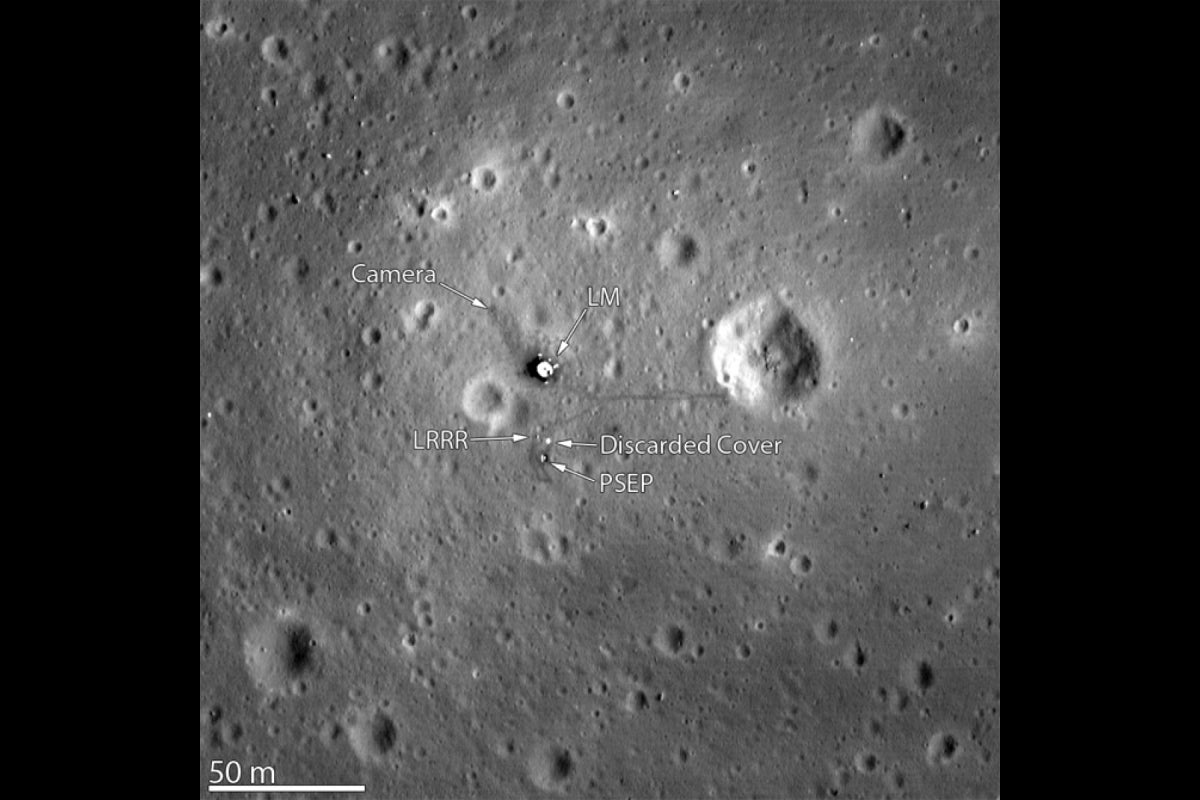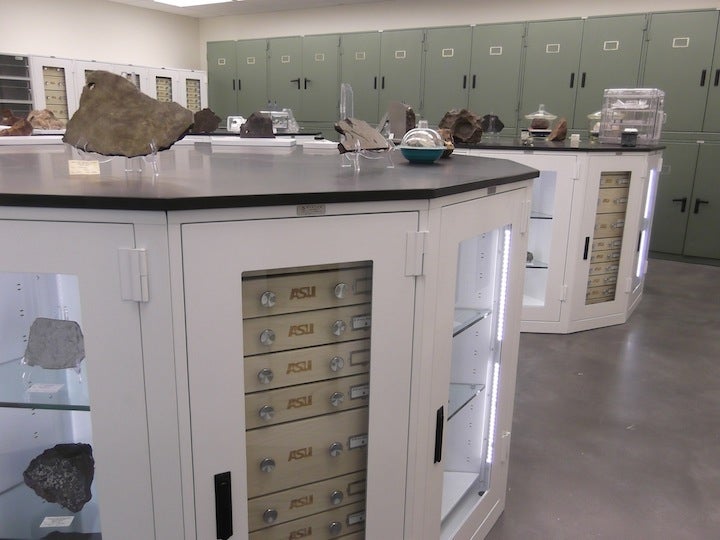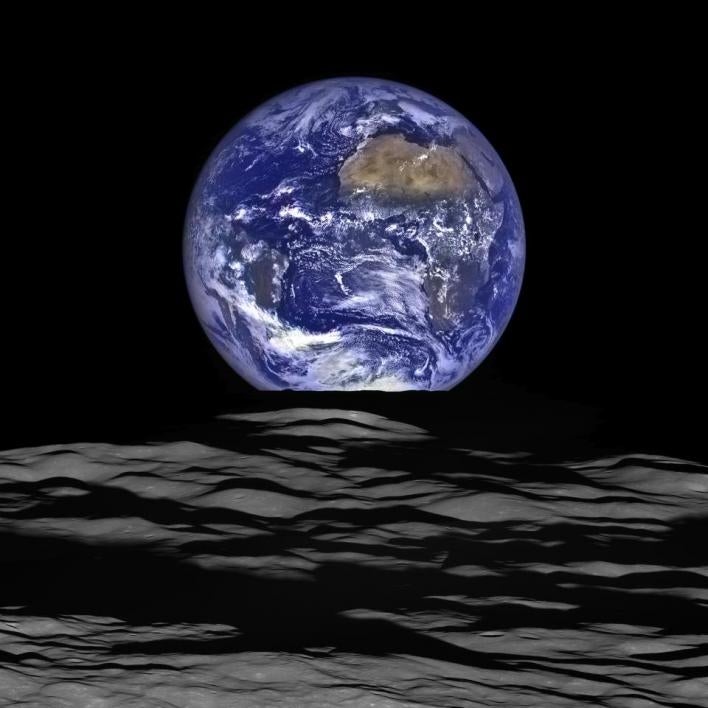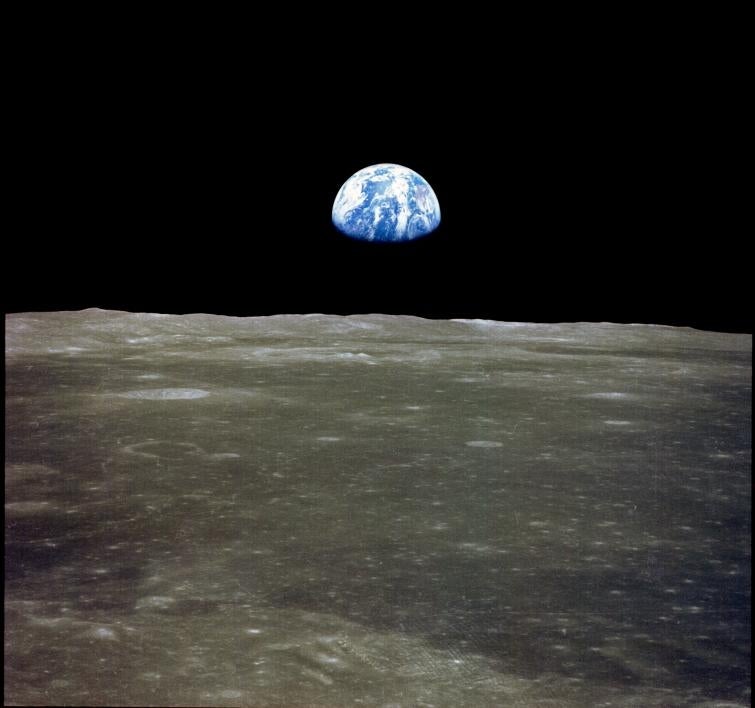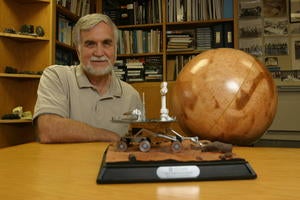Fifty years ago, the Eagle landed.
“Man on the moon!” said CBS television news anchor Walter Cronkite, whose exclamation would make for worldwide headlines the next day.
Cronkite was so caught up in the moment, he cast aside his usual objective reporter demeanor and let out an “Oh, boy … Whew, boy!” as he took off his glasses and rubbed his hands together in glee.
“Crowds around this country and all over the world are watching this, joined together in a singular celebratory moment for humanity,” he added.
During his annual visits to the ASU journalism school that bears his name, Cronkite once said it was his proudest broadcast moment.
On July 20, 1969, 600 million people across the globe watched that moment — the largest TV audience in history.
The world watched in awe and wonder during the mission's gripping 102-hour, 45-minute and 42-second-long duration that began with the mighty takeoff of the Saturn V rocket on July 16 and ended with the dramatic touchdown of the Eagle lunar lander in the Sea of Tranquility.
“A time that will be in the history books forever,” Cronkite said as the first grainy lunar surface images were beamed back to Earth.
One small step for man, one giant leap for mankind later, Neil Armstrong began NASA protocol: Pick up the precious moon rocks first, should they have to quickly abort the mission. He then scooped up a contingency sample of some moon soil.
It looked and felt like powdered charcoal, commented the then 38-year-old astronaut. "Fine, sandy particles ..." he said, as he took his first off-camera walkabout (the camera was attached to the leg of the lunar lander).
Then, the normally circumspect Armstrong paused to take in the view.
“It has a stark beauty all its own,” he said. “It’s like much of the high deserts of the United States. It’s different, but it’s very pretty out here.”
For the next 20 minutes, he had a new world all his own to explore.
Next, Buzz Aldrin descended onto the surface. “Making sure not to lock it (the lunar lander hatch) on my way out,” he joked. He echoed Armstrong's sense of awe with his first, succinct words from the surface: “Beautiful view. Magnificent desolation."
As Armstrong and Aldrin began to get acclimated and more confident with the moon's low gravity, their tentative small steps turned to giant leaps.
“A 3-foot first step in one-sixth gravity," Cronkite said. "Like walking on a trampoline. Isn’t that something? Boy, it looks like fun, doesn’t it?”
“Man on the moon!” said CBS television news anchor Walter Cronkite upon Neil Armstrong's first steps. Cronkite was so caught up in the moment, he let out an “Oh, boy …Whew, boy!” as he took off his glasses and rubbed his hands together in glee.
Apollo inspirations
Almost every American who owned a TV — 94% of them — tuned in to watch the wonder of the first humans on another world.
And among them were several future Arizona State University space explorers, including Mark Robinson. He was 10 years old at the time and remembers gathering around the television, like the rest of the world, in his parents' bedroom to watch the fuzzy broadcast.
“I was in my mom and dad’s bedroom, and it was a little black-and-white TV, about (2 feet), on a stand. I’ve got four brothers and sisters, and so we were all in there. And it was late at night. It was 9 p.m., I think."
The original NASA flight plan after the astronauts’ arduous journey was to let them nap.
“I do remember a lot of impatience. They landed; that’s really cool. But a 10-year-old can’t imagine, why don’t you just get out and play?”
Then, at 10:39 p.m. EDT, after what seemed like an eternity for a little boy, Armstrong emerged from the lander and came down the ladder.
“It was spellbinding. It was the first time human beings set foot on another world," Robinson said. "Just sitting there watching humans climb down the ladder to step on the moon. And when you are 10 years old, you really don’t understand the historical significance of it at all, it’s just the excitement of the moment. It was quite amazing. And obviously, it kind of shaped my whole career and made a lasting impression on me.”
Unknown at the time except for a select nervous few back at Mission Control in Houston, Armstrong harrowingly landed the Eagle with only precious seconds of fuel to spare.
Recently, for the first time in history, Robinson's research team recreated what Armstrong saw from his lander window that caused him to take some heroic, last-second evasive maneuvers and manually override the original computer-guided landing spot to avoid a lunar landing catastrophe. Instead of tranquil seas of smooth lunar surface, he saw large boulders and a football field-size crater that could have doomed the mission. It caused him to burn much of the remaining fuel necessary to stick the landing safely.
The Armstrong landing simulation was the latest in Robinson’s career fascination with Apollo. Working with the Johnson Space Center, his team also recently released to the public "March to the Moon," a complete digital repository for all of the hand-held camera photography captured during the Mercury, Gemini and Apollo programs, which flew between 1958 and 1972.
Video by Ken Fagan/ASU Now
Mapping the moon
On the 40th anniversary of Apollo 11, in the summer of 2009, Robinson's ASU team had the world's first opportunity to be able to retrace Armstrong and Aldrin's steps.
As the lead scientist operating a special camera onboard NASA's minivan-size Lunar Reconnaissance Orbiter (the Lunar Reconnaissance Orbiter Camera is called LROC), Robinson and his team just celebrated a decade exploring every crevice and feature, mapping almost the entire surface of the moon. (Sadly, he hasn't been able to photograph the U.S. flag from Apollo 11 yet, as it likely blew over during their takeoff.)
"Our mission was originally conceived to support a human return to the moon," Robinson said. “We've mapped the moon at two scales. Very high black-and-white resolution — you can actually see the tracks left behind by the astronauts. And also, at a moderate resolution with color. The LROC was also the first camera to map the moon at pretty good spatial resolution at ultraviolet wavelengths as well as visible. It's useful for mapping out the abundance of titanium — mining in the future — and also tells us about the age of the surface."
His team has taken more than 1 million individual snapshots, which are carefully stitched together to provide new data about the lunar surface. "Over the last 10 years, we’ve mapped the whole moon with the wide-angle camera, the color camera, and we are approaching mapping it over 100 times — but every time the lighting is different, so it’s new information. It’s not redundant."
On July 19, a gallery show will open with the best of these LROC images on display at his "Barnstorming the Moon" exhibit, open to the public for the next month at the monOrchid Gallery in downtown Phoenix.
While the site of the Apollo 11 landing, the Sea of Tranquility, was chosen for its smooth, flat surface to lessen the landing risk, LROC images have revealed the history of the moon to be anything but calm.
“One of our most amazing discoveries so far with the camera are these very small features about the size of a couple miles across at the biggest, and maybe a couple hundred yards at the smallest," Robinson said. "These are (geologically) very young volcanic flows, between 10 and 15 million years old. Before the LRO, the conventional wisdom was that vulcanism shut off a billion years ago. What it’s telling us is that that heat engine inside the moon has continued on almost to the present. So, maybe there are going to be eruptions on the moon in the future.
"On top of that, another discovery we’ve made are thousands of small fault lines that occur.”
These faults create moonquakes, where the ground buckles and goes up at sharp angles. Just as the moon’s gravitational pull influences the Earth’s ocean tides, the forces of our planet have been at work reshaping the crust of the moon’s pockmarked surface.
“They were predicted and seen in the Apollo images, but now we know they are distributed all around the moon," Robinson said. "So, there are large moonquakes taking place today. That’s also telling us something about the interior of the moon. And what’s even more interesting about them is the way they are oriented, that the stress fields of the moon are being affected by the Earth.”
Robinson's latest projects include peering 200 times deeper than LROC into lunar craters with his ShadowCam project or building a next-generation moon rover called Tycho. Recently, Robinson and his crew took Tycho on its maiden voyage in the Cinder Lake region of Flagstaff, the hallowed ground where Apollo astronauts trained in Arizona and rode Grover the rover before their lunar missions.
Video by Ken Fagan/ASU Now
ASU first joins the space race
Long before Apollo’s historic moment, ASU’s space race began in earnest with the recruitment of Carleton Moore, who came to ASU in 1961 and founded the ASU Center for Meteorite Studies.
“ASU has been involved in NASA space explorations since as long as NASA’s been around,” said Jim Bell, a School of Earth and Space Exploration professor, planetary explorer, science historian and popular book author who also leads the NewSpace Initiative at ASU.
At the time, the launch of the Soviet Sputnik satellite shocked the world and had the U.S. scrambling to catch up. The Cold War-fueled space race was on. President John F. Kennedy had promised to land men safely on the moon before the decade was over.
Moore’s vision and foresight saw to it that ASU would be first in line to get lunar samples — long before Apollo made its voyage.
“I had primarily been working on carbon in meteorites,” Moore said during an ASU library archive interview upon his retirement in 2003. “Essentially, we practiced on the meteorites. Most of the analyses at the time were to see how the solar system was formed and understand meteorites. But it was also practicing for the moon rock samples. So, when I applied to NASA, and because I had done the carbon analysis on meteorites, they said I would be the one to do it on the moon rocks.”
For Moore, the most harrowing part of the Apollo 11 mission was the return home, which could make or break several scientific careers.
“I remember when they went to the moon, and the place where I held my breath was the time for them to take off and come back. And they did,” Moore said.
As it turns out, Armstrong's first scoop would be among the most significant lunar rock samples. And eventually, Armstrong’s contingency dirt sample made its way into the hands of scientists, including Moore.
“The first sample that we got here at ASU was lunar soil, or properly called regolith, where they just took a scoop and scooped up some of the surface, and brought it back to the lunar receiving lab," Moore said. "I went to Houston to pick it up.
“I was on the lunar sample preliminary examination team in the quarantine labs in Houston. And I was one of the five or six scientists that got to the moon rocks first. And we were in the same place where the astronauts were kept to make sure diseases or things weren't brought back from the moon. We had to sign a form; if there was a break and it’s bad, we may have been in there for the rest of our lives — but it’s worth doing.”
Moore remembered the time like yesterday. On the evening of Oct. 9, 1969, his team placed the first lunar sample in their gas chromatograph instrument, looking for the presence of carbon.
“The wonderful thing is it was a dial like a dial on a clock. We pushed the buttons and we waited and all of a sudden, that clock started moving and we had carbon in the sample," he said. "It had about 120 parts per million of carbon in the sample in the moon rock.”
Because of the groundbreaking work he performed on the Apollo 11 samples, Moore’s expertise was tapped by NASA again and again during the rest of the Apollo missions.
All told, ASU got more than 200 lunar samples to analyze, and Moore’s team published their findings to world acclaim from the scientific community. His team’s data told a different story than what he had previously thought.
“In the beginning I thought that the rocks had very low carbon and the soil was very high in carbon. I thought the carbon might have arrived from the carbon-rich meteorites which bombarded the moon," he said. “Later on, I discovered that that isn’t so. We discovered that what happens is, any carbon that comes from the meteorites, the solar wind (high energy radiation) wipes the carbon off of the surface of the moon. But the radiation from the sun is so strong, the solar wind is driving carbon into the surface of the rocks. So, the carbon on the moon came from the sun.”
Walking in their footsteps
During his time at ASU, Moore also laid the groundwork for ASU’s big future in space. The stewardship of the finest meteor collection at any university was later passed on to Meenakshi Wadhwa, a cosmochemist fascinated by the formation and evolution of the solar system.
She was too young to remember the Apollo 11 mission but recalls her parents' stories of witnessing the event in India.
“At the time, we didn’t have a television in my home," Wadhwa said. "A lot of what my parents remember was a lot of the public viewings. In public places they would bring these televisions out and people would watch. Huge crowds, actually. And that’s how my parents remember the moon landings.”
Wadhwa has additional perspective from years of lunar, Mars and solar system analyses from the ASU meteorite collection and robotic solar system exploration.
“The analysis of lunar samples that were brought back from the moon in the 1960s and early 1970s — it completely changed our view of how the moon formed, its origin and how it's related to the Earth, for example,” said Wadhwa, who recently became the director of the School of Earth and Space Exploration.
"When I learned that there were samples that we could analyze, from these places, from the moon, and also from Mars as meteorites, I was totally hooked," she said. "I wanted to study these rocks and learn something about how these planets formed. To me, the Apollo samples from the moon as well as some meteorites that come from the moon, these are fascinating samples that can tell us a lot about the history of the moon. And similarly, meteorites from Mars can tell us so much about the geology and evolution of mars, the origin and evolution of Mars."
The moon rocks that came with Apollo also revealed the moon's fiery past for the first time. The samples showed that the Apollo 11 landing site in the Sea of Tranquility was once the site of tremendous volcanic activity, and the mostly smooth, flat surface was due to broad, thin flows of lava that had flooded the region. Later moon rock analyses revealed even more secrets, leading scientists to believe that a Mars-sized planet once collided with Earth, exploding into a ring of debris that formed the moon about 4.5 billion years ago.
“We learned it had to be a very hot origin for the moon because the samples we analyzed were extremely depleted in elements that are very volatile," Wadhwa said. "Elements that evaporate very quickly when things heat up were in lower abundance on the moon, and so we realized the moon had to have a very hot origin.
“Actually, the very first samples that were picked up by Neil Armstrong, scientists found these specks of white mineral called plagioclase, and just based on the presence of this white mineral, scientists proposed that there was a lunar magma ocean, an ocean of lava on the surface of the moon sometime in the past. And the white mineral actually formed as a flotation crust on the surface. And so, really, we understood a lot about the history of the moon and how it formed from analyzing these first samples that were brought back from the moon 50 years ago."

A panoramic view of Little West crater and the lunar module in the distance, photographed by Neil Armstrong. Photo courtesy of NASA
Giant leaps forward
Moore later hired Ron Greeley, who had also participated with NASA in astronaut training and mapping lunar landing sites. Later, he became the first interplanetary ASU scientific explorer, focusing on Mars.
"It was exciting to have him here; he was a major step in advancing space at ASU. He was the first one that came that did missions and experiments on planetary bodies," Moore said. "He was really the first person to reach out to the other planets.”
Greeley's projects included the Galileo mission to Jupiter, the Magellan mission to Venus and the Shuttle Imaging Radar orbiter around Earth. He was also part of the data analysis program for the Voyager 2 mission to Uranus and Neptune. His projects focused on the moons of these distant bodies.
Ron Greeley became the first interplanetary ASU scientific explorer, focusing on Mars.
Passionate also about Mars exploration, he was involved with several missions to the red planet, including Mariners 6, 7 and 9, Viking, Mars Pathfinder, Mars Global Surveyor and the Mars Exploration Rovers. He was a co-investigator for the camera system onboard the European Mars Express mission. Greeley died in 2011, and the Ron Greeley Center for Planetary Studies at ASU is one of 17 regional sites NASA has designated to archive images for educational and scientific use.
Greeley also hired Phil Christensen, who again put ASU on the international scientific map for space exploration through his work on Mars exploration and, more recently, a rendezvous of the OSIRIS-REx spacecraft with the meteorite Bennu. ASU has had key instruments onboard Mars missions for more than two decades.
Through their endeavors, ASU became world-renowned as a go-to university for the robotic exploration of the solar system.
Then in 2006, ASU began a multi- and transdisciplinary era with the formation of the School of Earth and Space Exploration. Founding Director Kip Hodges and later head of the school Lindy Elkins-Tanton came to ASU to guide the era of ASU’s 21st-century space exploration. Recently, Elkins-Tanton, who is also co-chair of the Interplanetary Initiative, handed over the reins of the school to Wadhwa in order to focus on her lead scientist role in the Psyche mission, which is set to launch in 2022.
The impact and legacy of the Apollo missions also helped shape the development of Elkins-Tanton's career.
"I do remember the Apollo 11 landing," said Elkins-Tanton, who was just 3 at the time. "I’m one of these blessed with a few very early memories, of which this is one. I remember sitting in our living room and watching on our black-and-white television with my parents and my brothers.
“But I didn’t become really, really excited about Apollo again until I was in graduate school and got to work on some of the return samples. I studied some of the samples that really hadn’t been studied since the year that they came back, and I reanalyzed them with modern instruments, and I looked at the handwritten notes of the people that had done it first and I looked at exactly the same places that they looked at."
Elkins-Tanton sees common themes in the exploration of the moon and the mission to asteroid Psyche.
“I remain interested in the mysterious ability we have to understand the inside of a rocky planet by looking at the volcanic material that erupts on the surface," she said. "It almost feels like therapy, or psychotherapy, like we can delve into the unconscious in a sense, the place we can’t physically reach and still find out what’s going on there by looking at what comes out of a volcano.
"I do think (Apollo 11) was a moment that changed everything forever,” Elkins-Tanton said. “And then, for the rest of my life, we haven’t been on the moon again. It’s time we go back."
Recently, Elkins-Tanton had a front-row seat at a return-to-the-moon endeavor from the commercial space company Blue Origin, where Jeff Bezos unveiled for the first time his company's plans for human lunar exploration.
ASU will develop one or more payload experiments to be launched aboard Blue Origin’s Blue Moon, a flexible lander delivering a wide variety of small, medium and large payloads to the lunar surface.
"It's wonderful to be working so closely with our skilled, innovative and entrepreneurial colleagues at Blue Origin,” Bell said. “This collaboration will provide opportunities for our students to get hands-on experience with space experiments and systems and for our faculty to make significant advances in space science, engineering and education.”
Bell likens the commercial space sector to the development of commercial aviation a century ago.
"NASA is partnering and funding them. Our tax dollars at work, just like the government funded the airline industry 100 years ago," he said. "There were a couple of entrepreneurs, some rich people who liked to fly. The government says, 'Hey, let’s do something useful with it,' and provides these juicy government contracts to deliver the mail. Now, they are doing some similar things."
The goal is to help bring the cost of launch down, which Bell says is the biggest barrier to space exploration, and in return, the companies are bringing innovations like landing and relanding rockets or using different fuels.
"Our goal is to explore space, to educate students, to rewrite the textbooks. Our job in the NewSpace initiative is to find commercial partners where we can get our goals done and they can get their goals done, too," Bell said. "The idea is to find entrepreneurial companies and make it a win-win for the university and the companies involved. Those new players have to compete for opportunities. If they (NASA) are investing taxpayer dollars, they want those missions to work."
Fire and ice
Besides the moon's fiery past, another exciting discovery for the lunar scientific community has been the presence of water ice deposits in the craters.
“What excites everyone is the moon is our nearest neighbor in the solar system,” said Assistant Professor Craig Hardgrove, who is leading a new ASU mission to explore and map the moon's water ice.
“Every night, you can look up, for the most part, and see the moon. It’s something everyone can connect to. It is in space and is a destination still relatively unexplored," he said. "So, I think the moon is a compelling destination for that reason; we can all see it and wonder, why is that there? In my field in particular, the thing I found most exciting is the presence of water and water ice at the south and north pole of the moon.”
Hardgrove leads the LunaH-Map mission, the first full-on spacecraft that ASU has developed entirely in house. They are building a shoebox-size spacecraft called a cube satellite, or cubesat.
“I think that’s why it’s important for ASU and it really demonstrates leadership in this area," he said. "This is the first deep space science cubesat mission.”
Hardgrove is part of a new generation of ASU explorers for whom the history of Apollo has served as inspiration.
“The inspiration I find today is that there was a time when NASA didn’t know how to land things on the moon,” he said, “and we didn’t know how to land things on Mars and how to explore the solar system. We are trying to figure that out today in sort of a new paradigm, particularly, with these very small spacecraft that we are trying to develop.”
And even though he wasn’t yet born at the time, Hardgrove has a family connection to Apollo — a keepsake in the form of a piece of the heat shield from one of the missions stored in a little glass capsule. His family was given the memento when his grandfather-in-law retired from NASA.
That reminder helps get him through the challenging times as the LunaH-Map mission fast approaches a 2020 launch date.
“I often want to talk to the people that were doing Apollo or whatever came before," Hardgrove said. "There was no playbook. That’s where we are at. We are inventing the playbook to do a mission at this scale. That’s terrifying and exciting and keeps me up at night.”
Hardgrove’s team hopes to generate a map that will identify the enrichments of water ice that exists.
“It’s also important for human exploration. So, NASA and many others want to send robotic explorers and eventually human explorers back to the moon. Understanding where the resources lie is a really important question, and how much is there. Water is a really important resource for human exploration, so if we can understand how much is there and exactly where it is, we’ll be able to plan future NASA missions or future commercial missions to the moon to actually harness that water as a resource.”
The human need to explore
The historian Daniel J. Boorstin wrote in “The Discoverers: A History of Man's Search to Know His World and Himself": “The most promising words ever written on the maps of human knowledge are terra incognita — unknown territory.”
The drive for exploration is entwined deep within the DNA of the human species. Perhaps this is the very heart of the collective, philosophical meaning of the Apollo missions 50 years later.
"That goal, that project, was the work of an entire generation of aerospace engineers, scientists, managers, administrators and educators who went on to do the space shuttle program and the robotic program that NASA does today," Bell said. "And, in many ways, that generation really is still there, doing that kind of work, trying to inspire the next generation, the next round of simply stated missions that engage the country, that push us as a nation and as species to higher places then we've ever been."
Making the Apollo mission happen involved uniting a country like never before, using 10 times the current NASA budget and know-how and efforts from all disciplines.
"It almost seems unbelievable,” Bell said. “It also seems like a miracle that it happened, with mid- to late-1960s technology. They did all of Apollo with not the computing power of your smartphone, but your key fob for your car. It was slide rules and manual calculations and a half-million people. That's something I didn't fully appreciate. How much teamwork is involved and how much no individual can make any of these things happen whether they are human missions or robotic missions. The large-scale projects that we as humans decide to do require teams to work together."
The collective ASU space projects seek to expand the human experience.
“We really don’t know what Psyche is, and we just want to go and learn the most fundamental things about it," Elkins-Tanton said. "It’s amazing to be doing something and adding to the sum of human knowledge this way."
She aims to include as diverse a group of people on her team as possible.
“Everyone is invited, and connected to everyone else in the world we can," she said. "That’s why we explore. That’s why we are going back to the moon, it’s because we can’t help ourselves. It’s because we as a species have got to go find out. And the only way that’s worthwhile, I think, is if everyone is invited to the party. That’s what I want Psyche to be.”
Because the nature of space missions typically take a decade or two from idea to execution, someone could very well be sitting in their middle school or high school class today, and become a key leader in a space mission tomorrow.
"I hope that is inspirational to people — you can come up with an idea and put it on the next NASA mission," Hardgrove said. "And NASA wants these types of spacecraft to be flying along to all their deep space missions, whether they are going to Mars, Jupiter, Europa, Titan, etc. Maybe there is a concept out there for a little tiny mission that NASA would never put on the big spacecraft, but they do on a cereal box. That’s a really fun idea that I hope is exciting for future generations interested in deep space exploration."
As teachers, all of ASU's space scientists want to pay it forward to inspire the next generation of explorers.
“I want to help young people imagine that you could be doing this,” Bell said. “This could be part of your future.”
A new world
For those future missions, the talents of journalists, broadcasters, historians and artists will be used to record, document and comment on these endeavors, as Cronkite once did.
Some time after the silver anniversary of Apollo 11, Cronkite reflected back on the human significance of the event he broadcast.
“That will be the one event of the 20th century, despite all the other great scientific and technological innovations and inventions that came down the line, that will live in history 500 years from now,” he said as he received a NASA Ambassador of Exploration Award on Feb. 28, 2006.
During the award ceremony, Cronkite drew parallels between Christopher Columbus' 1492 discovery of the Americas, Apollo 11 and future exploration.
"I think that 500 years from now the young people that are living on space stations and space cities and perhaps on the orbs themselves out there ... they will be recognizing (the moon landing as) the most important feat of all time."
Carleton Moore (left) chats with Mark Robinson after a special public screening of the documentary Apollo 11 at the ASU Marston Theater on Wednesday, July 17, 2019. Photo by Joe Caspermeyer
The ASU space explorer who started it all, Carleton Moore, understood that historical perspective. Among the almost 2,000 meteorites now in the ASU collection, there is one from France that fell to Earth in 1492.
At Moore’s retirement ceremony, ASU President Michael Crow said, “Remember, when all of us in this room are long gone, this meteorite collection will be here.”
Moore is proud of ASU's contributions to Apollo and the legacy of space exploration that continues onward today. “Fifty years have zipped by and now ASU is a winner in space,” the now 87-year-old emeritus professor said recently via email.
And for ASU, 50 years after Apollo, exploration will continue to be a way of life.
"This is a great time to be alive because we are exploring so many places in our solar system, and actually bringing back samples from many places in our solar system now," Wadhwa said. "Apollo happened 50 years ago. And human exploration of space since then has been limited to just low-Earth orbit. I think it’s so exciting with all of the commercial entities that are out there, and NASA pushing the frontiers as well, to really make it possible now for the human exploration of the moon, Mars, and possibly further.
"And ASU will be key and central to any endeavor that involves exploration of our solar system and beyond."
Top photo: Apollo 11 landed on the moon on July, 20, 1969, marking the first time humans had stepped on another world. Here, Buzz Aldrin is pictured on the moon's surface. Neil Armstrong, the first man on the moon, can be seen in the reflection on Aldrin’s visor. Photo courtesy of NASA
More Science and technology
Large-scale study reveals true impact of ASU VR lab on science education
Students at Arizona State University love the Dreamscape Learn virtual reality biology experiences, and the intense engagement it creates is leading to higher grades and more persistence for biology…

ASU-led space telescope is ready to fly
The Star Planet Activity Research CubeSat, or SPARCS, a small space telescope that will monitor the flares and sunspot activity of low-mass stars, has now passed its pre-shipment review by NASA.…

ASU at the heart of the state's revitalized microelectronics industry
A stronger local economy, more reliable technology, and a future where our computers and devices do the impossible: that’s the transformation ASU is driving through its microelectronics research…





